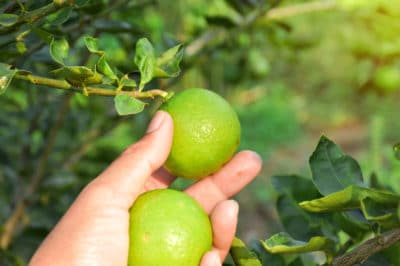Key Limes
Key lime trees (Citrus aurantifolia) thrive in the tropical to subtropical areas of USDA plant hardiness zones 9 through 11. Elsewhere, they do well as container plants overwintered indoors.
Key Lime Fruit
Key lime (Citrus aurantifolia) trees begin fruiting three to six years after planting. For Key limes, the best time to pick is when:
- Their color changes from green to yellow.
- Their skin has the texture of fine-grained leather.
- They feel heavy with juice and just slightly soft.
Although they fruit all year, Key lime trees are the most productive from August through December.
Expert gardener’s tip:Ripe Key limes that aren’t picked eventually fall from the tree. As long as they have no brown spots, they’re edible — and you won’t have to fight the tree’s thorns to get them!
Persian Limes
Less cold-sensitive than Key limes, Persian lime trees (Citrus latifolia) grow in USDA plant hardiness zones 8 through 11. The most widely commercialized of all limes, their fruit is shipped all over the world.
Persian Lime Fruit
These trees produce large, seedless oval limes, which are best picked after they’ve:
- Lightened from dark to “lime” green.
- Started to soften.
- Become heavy for their size, indicating that they’re full of juice.
For Persian limes, peak picking season lasts from July to September. May, June and October are the next-heaviest months. The remainder of the year, they fruit sporadically.
Expert gardener’s tip: It’s best to pick Persian limes before they turn yellow and drop. Otherwise, they’ll lose the acidity that gives them their tangy kick.
Green and Yellow Limes
Almost inevitably, some of a tree’s limes will develop yellow blotches. They’re almost certainly from sunburn and not a sign that the fruit is close to ripening.
Sunburned limes typically grow on a tree’s southern or western branches. As wind disturbs the surrounding canopy, parts of them become exposed to stronger sun than usual. As a result, they bleach to yellow.
Sunburn is purely cosmetic. The affected limes will develop normally, with no decrease in flavor or the amount of juice they contain.
